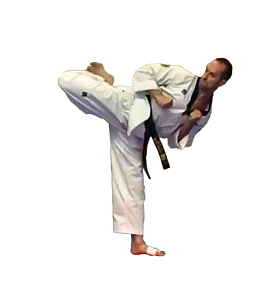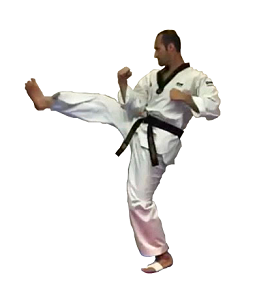Kicking Techniques
Chagi Kisul
차기 기술
There are 10 Basic Kick Skills (Kibon Bal Chagi Kisul / 기본 발 차기 기술) in Kukkiwon Taekwondo, each of which can have one or more Special Kick Skills (Teuksu Bal Chagi Kisul / 특수 발 차기 기술) applied to them to adapt the techniques for different variables that arise in a match such as distance and timing.
Other dojangs will have different classifications and categorizations. I have tried to be as in line with how modern Kukkiwon classifies techniques.
Please defer to your instructor’s preferred classifications, as always.
-
Front Kick
Ap Chagi / 앞 차기Turning Kick
Dollyeo Chagi / 돌려 차기Side Kick
Yeop Chagi / 옆 차기Back Kick
Dwi Chagi / 뒤 차기Axe Kick
Naeryeo Chagi / 내려 차기Whip Hook Kick
Huryeo Chagi / 후려 차기Scorpion Hook Kick
Nakka Chagi / 낚아 차기Twisting Kick
Biteureo Chagi / 비틀어 차기Inward Kick
An Chagi / 안 차기Outward Kick
Bakkat Chagi / 바깥 차기
-
No Pivot
The anchor foot is pointing at 0° relative to the target.Quarter Pivot (Small Pivot)
The anchor foot has turned on the ball of the foot to approximately 45° relative to the target.Half Pivot
The anchor foot has turned on the ball of the foot to approximately 90° relative to the target.Three-Quarter Pivot (Big Pivot)
The anchor foot has turned on the ball of the foot to approximately 135° relative to the target.Full Pivot
The anchor foot has turned on the ball of the foot to approximately 180° relative to the target.
-
Floor Pivot (Grounded Pivot)
The anchor foot turns while still in contact with the floor. A little bit of a heel lift is okay.Air Pivot (Aerial Pivot)
The anchor foot turns while in the air and lands in its end position.
Basic Kick Skills
기본 발 차기 기술
The basic version of each kick is performed by the rear leg.
Front Kick
Ap Chagi
앞 차기
“Ahp Chah-Gee”
Sometimes called Front Snap Kick.
Performed by chambering the leg at chest level then driving the ball of the foot forward into the opponent while the standing foot pivots slightly.
May also be applied with the sole or heel.
Upward Front Kick / 올려 앞 차기 / Ollyeo Ap Chagi can be used to strike the groin (by striking with the instep) or under the jaw, or can be used to strike a standing opponent while one is grounded.
Modified Examples:
Front Foot Front Kick
Ap Bal Ap Chagi
앞 발 앞 차기Twisting Front Kick / Front Cross Kick
Biteureo Ap Chagi / Ap Kkoa Chagi
비틀어 앞 차기 / 앞 꼬아 차기Push Front Kick
Mireo Ap Chagi
밀어 앞 차기
Turning Kick
Dollyeo Chagi
돌려 차기
“Dohl-L’yuh Chah-Gee”
Commonly abbreviated to “Turn Kick”. Also called Round Kick or Roundhouse Kick by other schools.
The anchor foot should pivot 135° to 180° immediately after chambering the knee, striking with the instep shortly after the end of the pivot.
May also be applied with the heel, the ball of the foot, or the bottom of the shin bone.
Half Turn Kick / Pan Dollyeo Chagi / 판 돌려 차기 is often utilized in Olympic Kyorugi, where the anchor foot only pivots to around 100° to 130°, delivering a more linear attack.
Short Turn Kick / Jalbeun Dollyeo Chagi / 짧은 돌려 차기 is often utilized in Olympic Kyorugi at clinch range, where the anchor foot pivots a minimal amount while the hips hinge back in order to deliver a kick to the hogu.
Downward Turn Kick / Naeryeo Dollyeo Chagi / 내려 돌려 차기 strikes in a downward arc rather than perpendicular, sometimes called a Question Mark Kick due to the path it travels through the air.
Modified Examples:
Tornado Kick
Dolgae Chagi
돌개 차기Fast Turn Kick
Ppaleun Bal Dollyeo Chagi
빠른 발 돌려 차기Triple Turn Kick
Sebeon Narae Chagi
세번 나래 차기
Side Kick
Yeop Chagi
옆 차기
“Yuhp Chah-Gee”
Sometimes called Side Thrust Kick or Side Piercing Kick.
Performed by chambering the knee towards the stomach while pivoting the anchor foot 180°, striking with the heel by driving it into the opponent. The kicker’s ear, shoulder, hip, knee and ankle must form a straight line at maximum kick extension.
May also be applied with the sole, ball (only to extend range when used as a checking or poking motion) or outer blade of the foot.
The Karate technique known as Side Snap Kick / Yoko Geri Keage / 横蹴り 蹴上げ is not present in Kukki Taekwondo, being a largely useless technique in the way it is commonly trained in modern times (directed in a rising fashion to the body or underarm). Originally it was described as a Front Snap Kick which extends to the side of the body (knee up, toes up) and over time has been misinterpreted.
Modified Examples:
Flying Side Kick
Ttwieo Yeop Chagi
뛰어 옆 차기Fast Side Kick
Ppaleun Bal Yeop Chagi
빠른 발 옆 차기Back Turning Side Kick
Dwi Dora Yeop Chagi
뒤 돌아 옆 차기
Back Kick
Dwi Chagi
뒤 차기
“D'wee Chah-Gee”
Performed by pivoting the anchor foot 180° while chambering the kicking leg along side the standing leg, driving the heel up towards the opponent with the foot flexed and the toes pointed down. The kicking foot should also “pivot” with the anchor foot to line the hips up, though this happens as it is leaving the floor.
Sometimes superfluously referred to as “Spinning Back Kick”. It’s actually more of a dorsal turn (rather than a circular spin) followed by a linear strike, though some martial arts styles don’t make a distinction between “turning” and “spinning”.
Often mistakenly identified as Back Turning Side Kick / 뒤 돌아 옆 차기 / Dwi Dora Yeop Chagi, but they are definitively not the same technique.
Modified Examples:
Switch Back Kick
Narae Dwi Chagi
나래 뒤 차기Jumping Back Kick
Jeompeu Dwi Chagi
점프 뒤 차기Counter Back Kick
Bada Dwi Chagi
받아 뒤 차기
Axe Kick
Naeryeo Chagi
내려 차기
“Neyh-L’yuh Chah-Gee”
Translates to “Downward Kick”. Sometimes also called “Chop Kick”, particularly in the UK.
Performed by chambering the leg at chest level then extending the foot above the face of the opponent, pivoting the anchor foot while driving downward with the heel while the foot is pointed.
May also be applied with the sole of the foot. Depending on the situation it can be done with or without a chamber and/or re-chamber.
Modified Examples:
Outward Axe Kick
Bakkat Naeryeo Chagi
바깥 내려 차기Inward Axe Kick
An Naeryeo Chagi
안 내려 차기Fast Axe Kick
Ppaleun Bal Naeryeo Chagi
빠른 발 내려 차기
Whip Hook Kick
Huryeo Chagi
후려 차기
“Hoo-L’yuh Chah-Gee”
Commonly abbreviated to just “Hook Kick” or “Whip Kick” rather than “Whip Hook Kick”.
Performed by chambering the leg like a side kick then extending the foot approximately 40° beside the target before traveling toward it in an arc, striking with the bottom of the heel while the leg is completely straight then re-chambering the knee either just before or just past the target.
May also be applied with the sole of the foot or the back of the heel.
Spinning Hook Kick / Dwi Huryeo Chagi / 뒤 후려 차기 (“Dwee Hoo-L’Yuh Chah-Gee”) is the most common form of this kick, which also goes by the name “Back Hook Kick”.
Usually executed as a Half Spin Hook / 180° Hook Kick in modern Olympic Kyorugi rather than as a full spin.
A well executed Whip Hook should strike the target in a side-to-side motion by using the hip to direct the thigh (and then foot) through the target, which is different from the Scorpion Hook which strikes in a back-to-front motion by bending the knee to pull the heel toward the body.
Modified Examples:
Back Hook Kick (Spinning Hook Kick)
Dwi Huryeo Chagi
뒤 후려 차기180° Hook Kick (Half Spin Hook)
180° Dwi Huryeo Chagi
180° 뒤 후려 차기540° Hook Kick
540° Dwi Huryeo Chagi
540° 뒤 후려 차기
Scorpion Hook Kick
Nakka Chagi
낚아 차기
“Nahk-Ah Chah-Gee”
Commonly abbreviated to just “Scorpion Kick” rather than “Scorpion Hook Kick”.
Performed by pulling the heel through the target after the leg has extended past. Common targets include the back of the opponent's head, neck and knee. In Olympic Kyorugi it also is used to the body from the clinch position.
May also be applied with the sole of the foot.
A well executed Scorpion Hook strikes in a back-to-front motion by bending the knee to pull the heel toward the body, which is different from the Whip Hook which strikes the target in a side-to-side motion by using the hip to direct the thigh (and then foot) through the target.
It is likely the least commonly used of the 10 Basic Kicks but it still requires a unique classification unto itself.
Modified Examples:
Front Foot Scorpion Kick
Ap Bal Nakka Chagi
앞 발 낚아 차기Spinning Scorpion Kick
Dwi Nakka Chagi
뒤 낚아 차기Grabbing Scorpion Kick
Japgo Nakka Chagi
잡고 낚아 차기
Twisting Kick
Biteureo Chagi
비틀어 차기
“Bee-Toor-Uh Chah-Gee”
Commonly abbreviated to just “Twist Kick”.
Performed by chambering the leg folded horizontally then twisting the upper body in the opposite direction of the strike while extending the instep outward to the opponent.
May also be applied with the ball of the foot.
It should have the feeling of a Front Kick being directed in a different direction than the body is turning.
Modified Examples:
Front Foot Twist Kick
Ap Bal Biteureo Chagi
앞 발 비틀어 차기Fast Twist Kick
Ppaleun Bal Biteureo Chagi
빠른 발 비틀어 차기Switch Twist Kick
Narae Biteureo Chagi
나래 비틀어 차기
Inward Crescent Kick
An Chagi
안 차기
“Ahn Chah-Gee”
Commonly abbreviated to just “Inward Kick”, the word “crescent” is not present in the Korean name of the technique.
“Bandal Chagi / 반달 차기” is sometimes used to refer to this kick, which translates to “Half-Moon Kick”. Some schools simply call this technique “Crescent Kick” with no distinction of its direction of motion.
Performed by chambering the leg similar to a front kick while the foot draws a circle from outside to inside, striking with the inner blade of the foot. The anchor foot pivots to facilitate striking through the opponent's face.
Alternate versions include keeping the leg straight throughout (no chamber) or bending the leg before impact at close range. In different context, it means kicking a target.
Modified Examples:
Front Foot Inward Kick
Ap Bal An Chagi
앞 발 안 차기Target Inward Kick
Pyojeok An Chagi
표적 안 차기Tornado Inward Kick
Dolgae An Chagi
돌개 안 차기
Outward Crescent Kick
Bakkat Chagi
바깥 차기
“Bah-Kaht Chah-Gee”
Commonly abbreviated to just “Outward Kick”, the word “crescent” is not present in the Korean name of the technique.
Bakkan Chagi 밖안 차기 is sometimes used to refer to this kick in newer Kukkiwon material. Some schools call this a “Reverse Crescent Kick”.
Performed by chambering the leg similar to a front kick while the foot draws a circle from inside to outside, striking with the outer blade of the foot. The anchor foot pivots to facilitate striking through the opponent's face.
Alternate versions include keeping the leg straight throughout (no chamber) or bending the leg before impact at close range.
Modified Examples:
Front Foot Outward Kick
Ap Bal Bakkat Chagi
앞 발 바깥 차기Fast Outward Kick
Ppaleun Bal Bakkat Chagi
빠른 발 바깥 차기Spinning Outward Kick
Dwi Dora Bakkat Chagi
뒤 돌아 바깥 차기





















